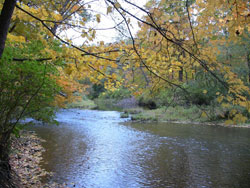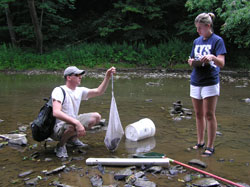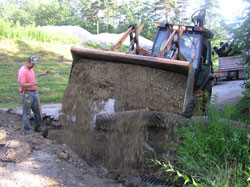Little Mahoning Progress Report
In the four years since the Western Pennsylvania Conservancy established a presence in the Little Mahoning Creek watershed, great strides have been made in protecting this Western Pennsylvania gem and the rare species that live here.

The lower Mahoning watershed covers approximately 274 miles. WPC has been actively involved in its conservation and restoration since 2006.
During the 20th century, Indiana County’s Little Mahoning Creek escaped significant damage from abandoned mine drainage, making it a rarity among Western Pennsylvania watersheds. This watershed is home to an abundance of aquatic life, is classified as a High-Quality Cold Water Fishery, a draw to trout anglers from across the nation.
However, the Little Mahoning faces new and serious threats. Erosion and sediment pollution and natural gas well drilling are all present dangers to the water quality of the Little Mahoning — and could imperil the animal species that live there.

Staff biologist Mike Holiday and intern Kelly Taylor weigh a Hellbender salamander.
A 2006 grant from Colcom Foundation enabled WPC to assess the watershed and determine where conservation efforts were most needed. “The middle and lower sections of the stream were the most impacted,” said WPC Director of Aquatic Science Eric Chapman. “The upper section is surrounded by 5,000-acre state gamelands, so there are relatively few problems.”
Sampling for macro-invertebrates — an excellent water-quality indicator — at 27 sites showed diverse insect populations on the upper stream, but depressed numbers and varieties below. The lower reaches had fewer of the stream’s 29 species of fish than the section in the headwaters near the gamelands.
Based on these findings, active work to restore the watershed began in 2008. In addition to creating buffers of vegetation around the stream, WPC planted a 10,000-square foot streamside area with native trees and shrubs at Little Mahoning Bible Camp, and stabilized 1,600 feet of nearby roadway by recycling coal-mine conveyor belts. “As a bonus, they act as speed bumps. It’s a low-cost solution to a dirt and gravel road problem.”

WPC staff install a culvert, which will help channel water.
Two state-protected mussel species — the round pigtoe and rainbow — are found in the Little Mahoning, a testament to the stream’s High Quality Cold Water status. Mussels are reproducing there, also indicating stream health.
Also present is the rare eastern hellbender salamander. One of WPC’s scientific studies on Little Mahoning involved pit-tagging (surgically inserting a microchip for identification) more than 80 hellbenders and tracking their survival and growth. “One sub-adult weighed about one pound when we started and has gained 30 to 40 percent of his body weight each year since,” said Chapman. “The largest hellbender we’ve caught so far was 26 1/2 inches long and weighed almost four pounds.”

Little Mahoning Creek.
The cost of WPC’s work in the watershed has totaled about $1 million, according to WPC Senior Director of Watershed Conservation and Conservation Services Nick Pinizzotto. “That’s pretty low, considering all we’ve accomplished so far. A lot of what we’re doing here is designed to prevent massive restoration later.”
It’s also paying off for watershed residents, many of whom are active partners in WPC’s work.
“I’m seeing more trout holding at the crib banks we installed, and more mergansers on the water, which tells me there’s plenty of bait fish in the stream,” said Little Mahoning Watershed Association Vice-president Mike Holiday, an avid angler and hunter. “I expect more improvements in the coming years.”
The watershed association has been around since 2001, but Holiday said it struggled until WPC put down stakes. “We floundered. We were unsure what to do,” he said. “The Conservancy provided direction and they’re making us self-sufficient, so we can sustain what we’ve accomplished in coming years.”
Get Involved
You can help WPC by volunteering your time! Click here to learn more.
